An online project under the direction of the CAPE ANN MUSEUM
inv. 443
Steam packet ship Mass., in a Squall, Nov. 10, 1845
Steam Packet Ship Mass. in a Squall, Nov. 10, 1845; Steam Packet Ship Massachusetts in a Squall Nov. 10, 1845; Steam Ship "Massachusetts" in a Squall, 1845
Lithograph Tinted (two stones: black key stone and gray-green tint stone) on paper 10 13/16 x 15 3/16 in. (27.5 x 38.5 cm) F.H. Lane del.
Lane & Scott's Lith., Tremont Temple Collections:
|
Related Work in the Catalog
Explore catalog entries by keywords view all keywords »
Historical Materials
Below is historical information related to the Lane work above. To see complete information on a subject on the Historical Materials page, click on the subject name (in bold and underlined).
The packet ship “Massachusetts” was the third engine-powered vessel to be built for Robert Bennet Forbes, and the largest American auxiliary steamship for mercantile use. Built at the East Boston shipyard of Samuel Hall, she had the lines of a conventional packet ship, the hull being full-ended to accommodate a large cargo, but carefully modeled to achieve moderate speed. Fitted with an engine and two boilers by Ericson and Delamater, her Ericson propeller could be raised and secured to her stern overhang to eliminate the resistance it would otherwise impose when not in use. Her engine was limited in driving power, making it most useful when sailing in light to moderate winds or maneuvering in port.
The first voyages of the “Massachusetts" were between New York and Liverpool, therein exposing the weakness of her power plant; a third voyage to Vera Cruz as a military transport led to further problems. In 1848, under Army control, she went to the West Coast, and was transferred to the Navy the following year. Her performance under sail was quite satisfactory, but in 1853, having returned to Norfolk, she underwent extensive repairs and improvements to machinery. Returning to the West Coast in 1855, “Massachusetts” spent the next seven years on coastal patrol, protecting settlers from conflict with Native Americans.
By 1862, the Navy had acquired another steamship named “Massachusetts” and re-named the vessel the “Farralones”, which was then cut down to a bark rig and had her engine removed. Sold to a San Francisco shipping firm in 1867, she was re-named “Alaska”, was used for trading voyages in the Pacific, and finally shipwrecked at Callao, Peru in 1871.
Erik Ronnberg
References:
Robert Bennet Forbes, “Personal Reminiscences” (Boston, MA: Little, Brown & Co., 1892), pp. 208-217.
Cedric Ridgely-Nevitt, “American Steamships on the Atlantic” (Newark, DE: University of Delaware Press, 1981), pp. 89 -97.
Phillips Library, Peabody Essex Museum
1011.2 F695
Also filed under: Forbes, Robert Bennet »
vol. 1, no. 1
January 1941
pp. 51-57
Also filed under: "Antelope" (Steam Demi-Bark) » // Forbes, Robert Bennet »
Book
University Press, John Wilson and Sons, Cambridge, Massachusetts
Second edition, 1882, contains "Rambling Recollections Connected with China." Google book version.
Also filed under: Forbes, Robert Bennet »
The term "ship," as used by nineteenth-century merchants and seamen, referred to a large three-masted sailing vessel which was square-rigged on all three masts. (1) In that same period, sailing warships of the largest classes were also called ships, or more formally, ships of the line, their size qualifying them to engage the enemy in a line of battle. (2) In the second half of the nineteenth century, as sailing vessels were replaced by engine-powered vessels, the term ship was applied to any large vessel, regardless of propulsion or use. (3)
Ships were often further defined by their specialized uses or modifications, clipper ships and packet ships being the most noted examples. Built for speed, clipper ships were employed in carrying high-value or perishable goods over long distances. (4) Lane painted formal portraits of clipper ships for their owners, as well as generic examples for his port paintings. (5)
Packet ships were designed for carrying capacity which required some sacrifice in speed while still being able to make scheduled passages within a reasonable time frame between regular destinations. In the packet trade with European ports, mail, passengers, and bulk cargos such as cotton, textiles, and farm produce made the eastward passages. Mail, passengers (usually in much larger numbers), and finished wares were the usual cargos for return trips. (6) Lane depicted these vessels in portraits for their owners, and in his port scenes of Boston and New York Harbors.
Ships in specific trades were often identified by their cargos: salt ships which brought salt to Gloucester for curing dried fish; tea clippers in the China Trade; coffee ships in the West Indies and South American trades, and cotton ships bringing cotton to mills in New England or to European ports. Some trades were identified by the special destination of a ship’s regular voyages; hence Gloucester vessels in the trade with Surinam were identified as Surinam ships (or barks, or brigs, depending on their rigs). In Lane’s Gloucester Harbor scenes, there are likely (though not identifiable) examples of Surinam ships, but only the ship "California" in his depiction of the Burnham marine railway in Gloucester (see Three Master on the Gloucester Railways, 1857 (inv. 29)) is so identified. (7)
– Erik Ronnberg
References:
1. R[ichard)] H[enry] Dana, Jr., The Seaman’s Friend, 13th ed. (Boston: Thomas Groom & Co., 1873), p. 121 and Plate IV with captions.
2. A Naval Encyclopaedia (Philadelphia: L. R. Hamersly & Co., 1884), 739, 741.
3. M.H. Parry, et al., Aak to Zumbra: A Dictionary of the World’s Watercraft (Newport News, VA: The Mariners’ Museum, 2000), 536.
4. Howard I. Chapelle, The History of American Sailing Ships (New York: W.W. Norton & Co., 1935), 281–87.
5. Ibid.
6. Howard I. Chapelle, The National Watercraft Collection (Washington, DC: Smithsonian Institution, 1960), 26–30.
7. Alfred Mansfield Brooks, Gloucester Recollected: A Familiar History (Gloucester, MA: Peter Smith, 1974), 67–69.
Photograph
From American Clipper Ships 1833–1858, by Octavius T. Howe and Frederick C. Matthews, vol. 1 (Salem, MA: Marine Research Society, 1926).
Photo caption reads: "'Golden State' 1363 tons, built at New York, in 1852. From a photograph showing her in dock at Quebec in 1884."
Also filed under: "Golden State" (Clipper Ship) »
Oil on canvas
24 x 35 in.
Peabody Essex Museum, Salem, Mass.
Walters' painting depicts the "Nonantum" homeward bound for Boston from Liverpool in 1842. The paddle-steamer is one of the four Clyde-built Britannia-class vessels, of which one is visible crossing in the opposite direction.
View related Fitz Henry Lane catalog entries (2) »
Also filed under: Packet Shipping » // Walters, Samuel »
"Engine-powered vessel" is a collective term used by nautical historians to include all vessel types using engine power of any type for propulsion, whether assisted by sails, oars, or other motive power. In Lane's time, steam reciprocating engines fueled by wood or coal were the only practical source of this power for ships using paddle-wheels or screw propellers to convert heat energy into motion.
For most of the nineteenth century, steamships had sails for auxiliary power; indeed the earliest examples relied principally on sails, using engine power in calm weather to shorten the voyage time or keep to a schedule. As engines became more efficient, powerful, and reliable, sail plans were reduced, to be used only to steady a vessel's motion in a seaway (for the sake of seasick passengers), or to maintain headway if the engine broke down. Only harbor craft, ferry boats, and coastwise passenger steamers relied solely on engine power.
Among Lane's depictions of steamships, the auxiliary steam packet Auxiliary Steam Packet Ship Massachusetts (inv. 442) is a good example of primary reliance on sails, while the steam demi-bark The "Britannia" Entering Boston Harbor, 1848 (inv. 49) and the Cunard Liner "Britannia", 1842 (inv. 259) have relegated sails to secondary (or simply emergency) motive power.
– Erik Ronnberg
Castine Historical Society Collections (2015.03)
Also filed under: Historic Photographs » // Steamers »
Published by James French, Boston
Volume 1848-49
Boston Public Library
Call number 39999059856813
See p. 30 of directory.
Also filed under: "Britannia" (Cunard Steamship) » // "Caledonia" (Cunard Steamship) » // Trade Routes and Statistics »
Cartoon
9 1/4 x 13 3/4 in (23.495 x 34.925 cm)
Peabody Essex Museum, Salem, Mass.
Jonny and a Yankee:
Jonny: "Ho my Hi! 'ow she goes!! it his'nt fair I ham sure t'aint!!! She must 'av an engine hunder the keel..."
Yankee: "Where are your yachts now, Jonny? s-a-y- Do you think your wash tubs can come up to a real Yankee Clipper? Sorry for you, Jonny, but it can't be helped... A Yankee Ship a Yankee Crew, you know Jonny."
Also filed under: "America" (Schooner Yacht) »
Lithograph
Library of Congress Catalog Number 2002706878
Design of side wheel steamer showing wheel mechanism, side view and cross-section in ten figures. This design proved a failure in the few vessels that employed it. The paddle wheel enclosures filled with water, causing resistance which greatly impaired efficiency and increased fuel consumption.
– Erik Ronnberg
Oil on canvas
Maine Maritime Museum
Also filed under: Castine »
Steamer schedules for 1855, including the schedule for the steamer, "T. F. Secor" which served Castine, see pp. 234–35.
Also filed under: "T. F. Secor" (Steamboat) » // Castine » // Publications » // Steamers »
Robert Bennet Forbes (1804–89) of Boston was a key figure in his family's business in the China trade. While his brothers and cousins took positions as land-based merchants stationed either in Boston or Canton, Robert Bennet Forbes chose life at sea. He went on many trips to China, starting in 1817 as a cabin boy—thirteen years old—and eventually as a ship captain.
Forbes became a partner in the firm in 1832, known by then as Russell & Co., Canton, and went for a two-year trip to China in 1838–40 as a merchant. He was a proponent of steam power, which helped ships on the long voyage to China and Japan, and gave them the speed to evade the pirates who were ever present in the opium trade. His firm built about 70 ships, of which he was owner or part owner of several.
Robert Bennet Forbes also helped to introduce yachting as a sport, and participated in some of the first yacht races. His book Personal Reminiscences, published in 1892, lists many of these exploits, as well as all of the vessels he owned and built.
Forbes was known for his adventurous spirit. In 1846, when news of the Irish famine reached Boston, he convinced the U.S.Navy to lend him the "USS Jamestown" to take food to famine sufferers in 1847. He was the first civilian given the honor of commanding a naval vessel, and he crossed the Atlantic in a record seventeen days. Forbes wrote a book about his trans-Atlantic voyage for which he commissioned Lane to make the frontispiece illustration.
The "Jamestown" commission was one of several works Lane made for Forbes. Forbes was not only adventurous but innovative, and he commissioned Lane to make works after two of his newly designed steam vessels: the "Massachusetts," a packet ship that used steam power to supplement wind power, and the "Antelope," that relied primarily on steam power.
The Forbes family lived in Milton, Massachusetts, and also had a home in Beverly, Massachusetts. In 1856 Forbes bought land in West Manchester and built a summer home there which he christened "Masconomo" after the sagamore, chief of the Agawam.
In 1834 Captain Forbes married Rose Greene Smith. She died September 18, 1885, having borne her husband three children: Robert Bennet Forbes (1837–June 30, 1891); Edith Forbes, who married Charles Eliot Perkins; and James Murray Forbes (b. July 17, 1845). He died on November 23, 1889 in Milton.
As reproduced in Yankee Sailing Ship Cards by Allan Forbes and Ralph M. Eastman (Boston: State Street Trust Company, 1948).
Also filed under: "Eastern Star" (Bark) » // Signal Systems (Flags & Maritime Codes) »
Phillips Library, Peabody Essex Museum
1011.2 F695
Also filed under: "Massachusetts" (Auxiliary Steam Packet Ship) »
vol. 1, no. 1
January 1941
pp. 51-57
Also filed under: "Antelope" (Steam Demi-Bark) » // "Massachusetts" (Auxiliary Steam Packet Ship) »
Typed transcription of photograph caption
Manchester Historical Museum, Manchester, Mass.
Also filed under: Manchester, Mass. »
map
Manchester Historical Museum
Also filed under: Manchester, Mass. »
c. 1857
Manchester Historical Museum
In 1856 Robert Bennet Forbes bought nineteen acres of land for $2,800 from Israel F. Tappan in the section of the West Manchester shore known in those days as Newport. There he built Masconomo, named for the sagamore of the Agawam. In her unpublished letters to her son Robert, his wife Rose Greene Forbes wrote:
"...I think Father will put up a good sized cheap summer house, rough pillars, pine furniture etc., and very likely we shall all be there for two months next summer. He means to show people how rational people ought to live at the seaside. What nice times we shall have..."
The house was sold to Benjamin G. Boardman in 1865.
Also filed under: Manchester, Mass. »
Book "Family Photographs" 1:45
Privately Printed: The Riverside Press
Collection of the Forbes House Museum.
Also filed under: Forbes, John Murray » // Manchester, Mass. »
Book
University Press, John Wilson and Sons, Cambridge, Massachusetts
Second edition, 1882, contains "Rambling Recollections Connected with China." Google book version.
Also filed under: "Massachusetts" (Auxiliary Steam Packet Ship) »
Also filed under: Forbes, John Murray »
Robert Bennet Forbes scrapbook
vol. 1, p. 4
Phillips Library, Peabody Essex Museum (SCR 4)
"SPLENDID NAVAL VICTORY. We have received intelligence by the arrival of the Caledonia of one of the most splendid naval victories ever achieved under the American flag..." This article is a humorous metaphor, comparing Forbes' mission to bring food to the starving Irish to a naval assault on the city of Cork.
Also filed under: "Caledonia" (Cunard Steamship) » // "Jamestown" (U.S. Sloop of War) » // Newspaper / Journal Articles »
Perhaps painted in Canton
Collection of the Forbes House Museum
Given to the Forbes House Museum by H.A. Crosby Forbes, Ph.D., Robert P. Forbes, Ph.D., and Douglas B. Forbes in 2012
The painting was commissioned by Robert Bennet Forbes to commemorate the death of his brother, Thomas Tunno Forbes, in 1829 on "The Haide" during a storm off the coast of Macao.
Collection of the Forbes House Museum, Milton, Mass.
Scene depicts the "Jamestown" being towed out of Charlestown Navy Yard. Plaque reads: "To Captain R. Bennett [sic] Forbes / From his English friends. / The "Jamestown" American Sloop of War as she left Boston under his command / bound to CORK with DONATIONS of FOOD / freight free for the Irish. / 1847."
Also filed under: "Jamestown" (U.S. Sloop of War) »
Boston
Eastburn's Press
Link to Google Books.
Also filed under: "Jamestown" (U.S. Sloop of War) » // Lane & Scott's, Lith. – Boston » // Professional »
16 1/2 x 20 1/2 in., on sheet 18 1/8 x 22 1/2 in.
Courtesy American Antiquarian Society, Worcester, Mass.
One of these lithographs was given to R. B. Forbes at an event held on the 19th of April at the Cork Temperance Institute.
"U.S. Sloop of war, Jamestown: Capt. R. B. Forbes. This print, commemorative of the splendid generosity of the American government in dismantling a ship of war for a mission of peace and charity, & of the noble-hearted citizens who humanely & benevolently responded to the call of Irish distress, is respectfully dedicated to the President, House of Representatives, Congress and people of the United States of America, by their obedt. servants, George M. W. Atkinson, William Scraggs, Cove of Cork 13th April, 1847"
Also filed under: "Jamestown" (U.S. Sloop of War) »
Collection of the Forbes House Museum, Milton, Massachusetts
Gift to R. B. Forbes from the U.S. Navy to commemorate voyage of the "Jamestown."
Also filed under: "Jamestown" (U.S. Sloop of War) »
Lane & Scott's Lithography was a Boston-based firm formed by Fitz Henry Lane and John W. A. Scott. The partnership spanned 1844–48, after both artists had apprenticed for prominent Boston lithographer, William Pendleton. The firm was located at 16 Tremont Temple, Boston and created sheet music covers, book illustrations, advertisements, prints, and town views. Lane left the firm around 1847 or 1848 and Scott printed some works under his own name.
This information has been summarized from Boston Lithography 1825–1880 by Sally Pierce and Catharina Slautterback.
9 x 14 in.
Cape Ann Museum Library & Archive
Showing Lane's neighborhood while working in Boston. Lane had studios at the intersection of Washington and State Streets, Summer, Tremont and School Streets.
Also filed under: Boston City Views » // Maps » // Professional » // Residences » // Tremont Temple »
Boston: : Printed for the author, by C.C.P. Moody, Old Dickinson Office–52 Washington Street., 1851
Courtesy of the American Antiquarian Society, Worcester.
Call Number LML Plym Russ P851
American Antiquarian Society copy of book inscribed: Belonging to J.G. Orton. Bought in Pilgrim Hall Plymouth, Mass. Oct. 10th 1851
Map of Plymouth Village in 1846 signed: Lane & Scott's Lith., Boston
Boston
Eastburn's Press
Link to Google Books.
Also filed under: "Jamestown" (U.S. Sloop of War) » // Forbes, Robert Bennet » // Professional »
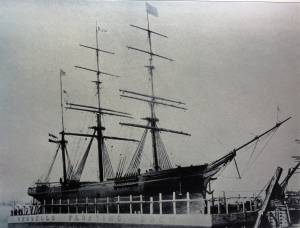
_sm.jpg)

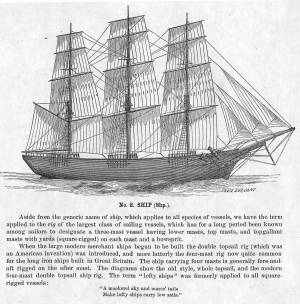
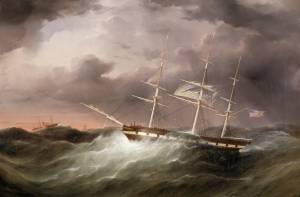


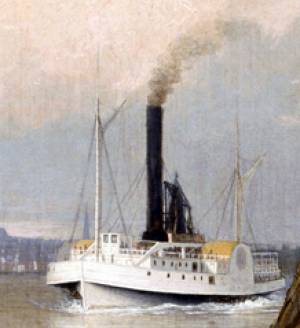

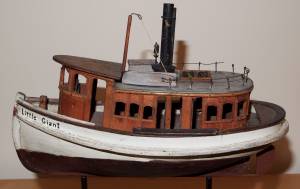

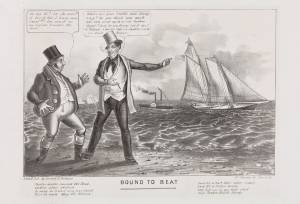

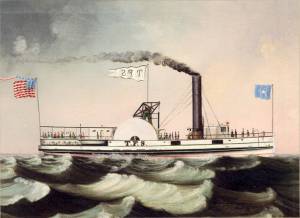




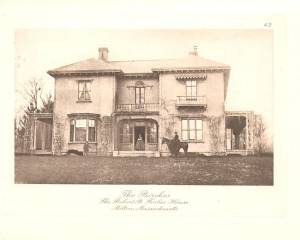
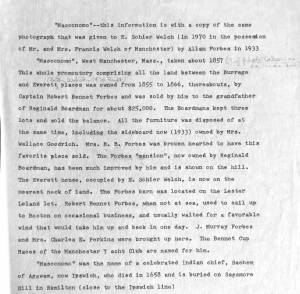
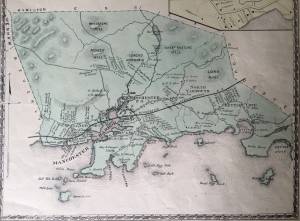
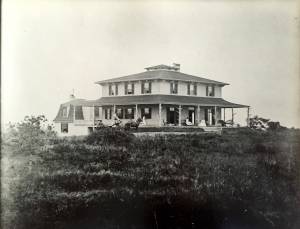
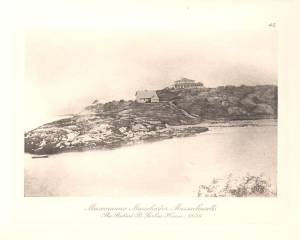
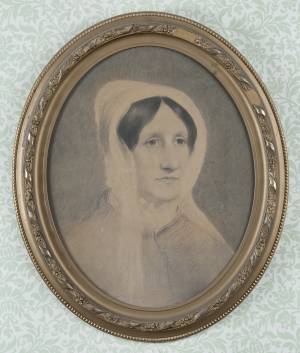


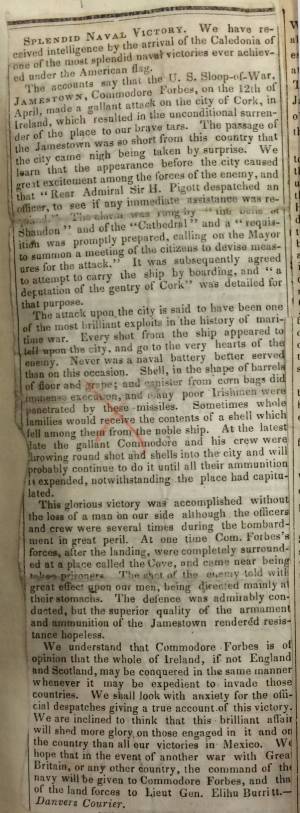
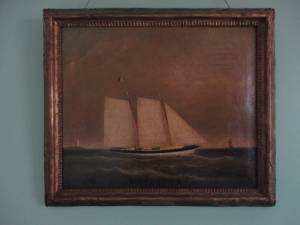
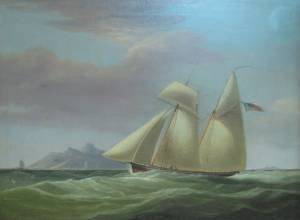

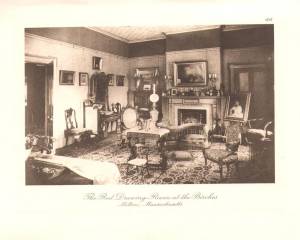


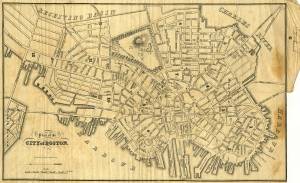
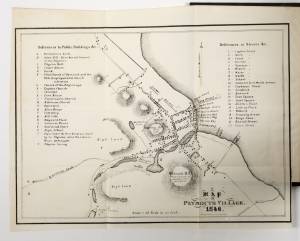
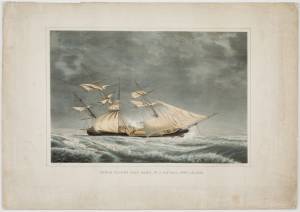
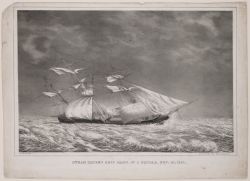
Commentary
This lithograph was drawn by Lane and printed by Lane & Scott. It is likely that the print was produced for, and published by, R.B.Forbes.
The packet ship “Massachusetts” was the third engine-powered vessel to be built for Robert Bennet Forbes, and the largest American auxiliary steamship for mercantile use at the time. Built at the East Boston shipyard of Samuel Hall, she had the lines of a conventional packet ship, the hull being full-ended to accommodate a large cargo, but carefully modeled to achieve moderate speed. The first voyages of the “Massachusetts" were between New York and Liverpool, therein exposing the weakness of her power plant.
Lane probably made this undated lithograph in 1846, the year following the date on the print on which “Massachusetts” encountered a late autumn squall. It shows the vessel sharply heeled, her staysail and jibs torn, the main course’s weather tack and sheet parted, and squaresails aloft flogging wildly. Lane also made another print of the "Massachusetts" Auxiliary Steam Packet Ship Massachusetts (inv. 442). Forbes’s optimism for this vessel’s future could not have lasted long and whatever promotional value the images had for this venture would soon dissipate, hence their scarcity.
– Erik Ronnberg
References:
Robert Bennet Forbes, “Personal Reminiscences” (Boston, MA: Little, Brown & Co., 1892), pp. 208-217.
Cedric Ridgely-Nevitt, “American Steamships on the Atlantic” (Newark, DE: University of Delaware Press, 1981), pp. 89 -97.
[+] See More